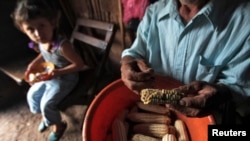Latin American governments have pledged to work toward ending hunger within a decade while tackling the region's rising obesity — itself considered a form of malnutrition.
At a regional meeting of the U.N. Food and Agriculture Organization, government representatives from across Latin American and the Caribbean drew up plans to accelerate cuts in hunger, which has been halved in the region in the last 25 years.
At the same time, far more attention needs to be paid to combating obesity, particularly among women, in a region where nearly a quarter of all adults are obese, the FAO said.
"Countries have been very clear: The regional priority is to eradicate hunger by 2025," Jose Graziano da Silva, head of the FAO, said at the meeting in Mexico City, which ended Thursday.
Efforts to combat hunger will focus on Central America's "dry corridor" running through Guatemala, El Salvador and Honduras, where millions of people have been affected by a prolonged drought exacerbated by climate change.
"Today, climate change has caused those droughts to be more erratic, prolonged and unpredictable," Graziano da Silva said.
He said Latin America and the Caribbean could be the first region to achieve two of the U.N.'s Sustainable Development Goals — eradicating hunger and poverty — five years before the proposed target dates of 2030.
Hunger reduction goal
Since 1991, the number of hungry people in Latin America and the Caribbean has fallen to 34 million from 66 million, and the region was the only one that met the U.N. Millennium Development Goals on reducing hunger by 2015, the FAO said.
Aid in the form of conditional cash transfers targeting poor families, pioneered by some of the region's biggest economies, including Brazil, has meant people have had more money to spend on food. But changing diets have contributed to growing obesity, with nearly a third of women and 4 million children now obese in the region.
Programs aimed at making it easier for family farmers to access credit, insurance, seeds and fertilizers to encourage them to grow traditional food crops are one way of addressing the problem, Graziano da Silva said. Production of such foods will promote better diets and reduce malnutrition, he said.
Initiatives that encourage local governments to buy produce directly from farmers to provide healthy food for school meals, already well-established and hailed as a success in Brazil, will be promoted across Latin America, the FAO said.
The agency said more needs to be done to help subsistence farmers adjust to the impact of climate change, which brings increasing extreme and erratic weather from drought to flooding.
Latin America's agricultural sector lost $11 billion because of natural disasters between 2003 and 2013, the FAO said.
Efforts must also focus on promoting sustainable fishing. Three more countries need to ratify the International Agreement on Port State Measures, which seeks to combat illegal fishing, for it to come into effect, the FAO said.
